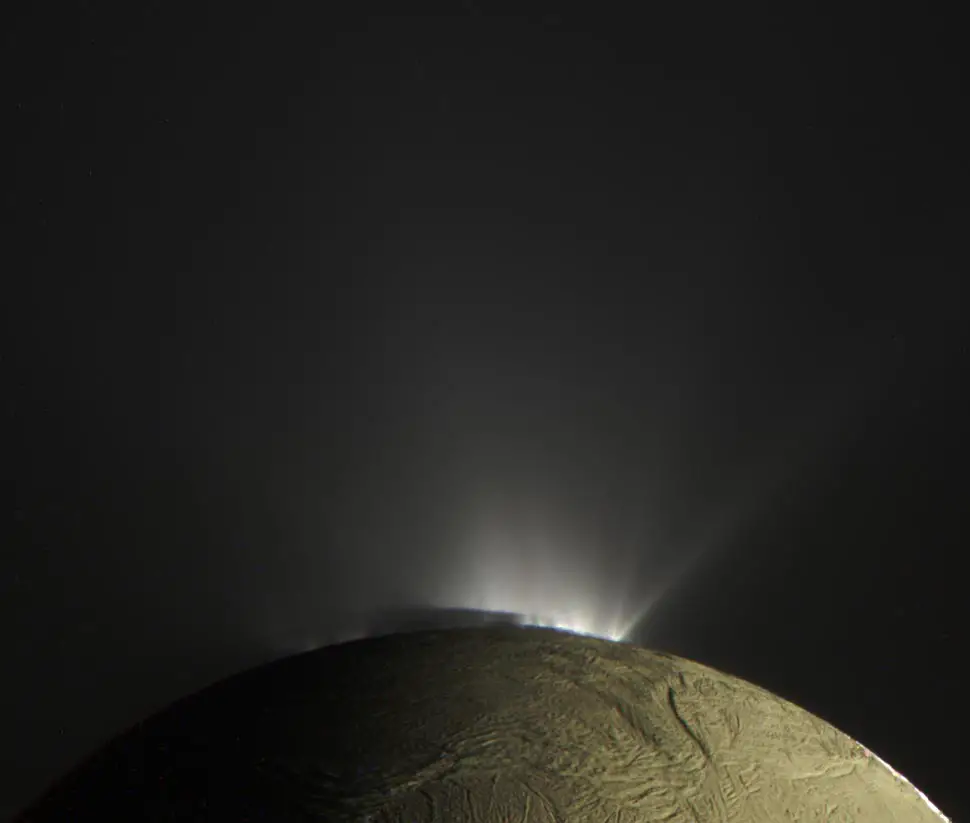Study Confirms Existence of Key Element for Life on Saturn’s Icy Moon Enceladus
Enceladus, one of Saturn’s moons, has captured the attention of researchers as a potential host for extraterrestrial life. A groundbreaking study conducted by scientists from Freie Universität Berlin has now provided evidence of the presence of phosphorus, a crucial building block for life, in Enceladus’ subsurface ocean. By analyzing data from the Cassini space mission, the international team detected phosphates in ice particles, which originated from the moon’s ice-covered global ocean and were ejected into space through cryo-volcanic plumes. The findings, published in the journal Nature on June 14, 2023, shed new light on the habitability of celestial bodies in the outer solar system.
Professor Frank Postberg, the lead researcher and a planetary scientist at Freie Universität Berlin, emphasizes the significance of the discovery: “Previous geochemical models were divided on the question of whether Enceladus’ ocean contains significant quantities of phosphates at all. These Cassini measurements leave no doubt that substantial quantities of this essential substance are present in the ocean water.” Phosphorus, in the form of phosphates, plays a vital role in the formation of DNA and RNA, cell membranes, and ATP—the energy carrier in cells. Its existence is fundamental to life as we understand it.
The researchers’ findings have important implications for the search for habitable environments beyond Earth. Dr. Fabian Klenner, an early-career researcher involved in the study, states, “By determining such high phosphate concentrations readily available in Enceladus’ ocean, we have now satisfied what is generally considered one of the strictest requirements in establishing whether celestial bodies are habitable.” Dr. Nozair Khawaja, another member of the research team, adds that the next step is to investigate whether Enceladus’ habitable ocean is actually inhabited.
The Cassini-Huygens spacecraft, a joint mission by NASA and ESA, made significant contributions to our understanding of Enceladus. It discovered the moon’s subsurface liquid water ocean and examined samples from the plume of ice grains and gases erupting into space from cracks in its icy crust. Previous studies by Postberg’s team had already revealed Enceladus’ “soda ocean” rich in dissolved carbonates and the presence of diverse organic compounds. The recent discovery of phosphates further supports the moon’s potential for hosting life.
The phosphates detected in Enceladus’ subsurface ocean are not locked within rocky minerals but dissolved as salt, enhancing their bioavailability. Their concentrations were found to be at least 100 to 1,000 times higher than those in Earth’s oceans. To understand how Enceladus maintains such high phosphate concentrations, the researchers conducted laboratory experiments in collaboration with teams in Japan and the United States.
The implications of this discovery extend beyond Enceladus. Planetary science has revealed that oceans beneath icy surfaces are common in our solar system, containing far more water than all of Earth’s oceans combined. These subsurface oceans exist on icy moons such as Ganymede, Titan, and Enceladus, as well as more distant celestial bodies like Pluto. Unlike planets with surface oceans, worlds with interior oceans can exist over a wider range of distances from their host stars, significantly expanding the potential for habitable environments throughout the galaxy.
While the presence of phosphates confirms Enceladus’ habitable environment, the search for actual life on the moon continues. The limitations of the Cassini spacecraft, launched in 1997, call for future missions to delve deeper into the mysteries of this fascinating moon.
Table of Contents
Frequently Asked Questions (FAQs) about Extraterrestrial habitability
What did the study discover about Enceladus’ subsurface ocean?
The study discovered the presence of phosphorus, a key building block for life, in Enceladus’ subsurface ocean. The phosphorus was found in the form of phosphates in ice particles ejected into space from the moon’s cryo-volcanic plume.
Why is phosphorus important for life?
Phosphorus is essential for life as we know it. It plays a vital role in the creation of DNA and RNA, cell membranes, and ATP—the universal energy carrier in cells. Life on Earth would not exist without phosphorus.
What does this discovery mean for the potential habitability of Enceladus?
The presence of phosphates in Enceladus’ ocean is a significant step in establishing the moon’s habitability. The high phosphate concentrations suggest that Enceladus meets one of the strict requirements for a celestial body to be habitable. Further exploration is needed to determine if the habitable ocean is actually inhabited.
How did the Cassini spacecraft contribute to the study?
The Cassini spacecraft, deployed by NASA and ESA, made important contributions to our understanding of Enceladus. It discovered the moon’s subsurface ocean and collected samples from the plume of ice grains and gases erupting from cracks in its icy crust, providing valuable data for the study.
Are there other celestial bodies with subsurface oceans?
Yes, there are several other celestial bodies in our solar system with subsurface oceans. These include Ganymede and Europa (moons of Jupiter), Titan (moon of Saturn), and even more distant bodies like Pluto. The presence of subsurface oceans greatly expands the potential for habitable environments in the universe.
Has life been found on Enceladus?
As of now, life has not been found on Enceladus. The capabilities of the Cassini spacecraft, launched in 1997, were limited in terms of detecting life. Future missions and further exploration will be necessary to investigate the possibility of life on this intriguing moon.
More about Extraterrestrial habitability
- Nature: Detection of phosphates originating from Enceladus’s ocean
- NASA: Saturn’s Moon Enceladus
- ESA: Cassini-Huygens
- NASA: Cassini Grand Finale


